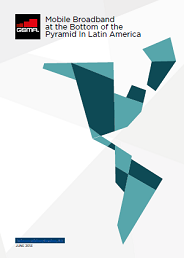A new report published today by GSMA Latin America reveals that mobile broadband has the potential to bridge the digital divide and connect 149 million people that live today at the bottom of the socio-demographic income pyramid. Mobile data plans that have reduced their rates by 52 per cent in the last three years and the introduction of innovative pre-paid daily plans are allowing access to the Information Society for the first time to many users at the bottom of the income pyramid.
The new report by the Telecom Advisory Services and commissioned by the GSMA shows how mobile will be the best alternative way to universalize internet access in Latin America. Mobile networks deployed in Latin America have been technological platforms to resolve the demand gap for voice telephony, which now most people have access. The study argues that following the trend of mobile telephony, mobile operators, stimulated by the competition effect, would allow to reduce the ‘affordability barrier’ for data services faced by lower-income sectors.
The bottom of the socio-demographic pyramid in Argentina, Brazil, Colombia, Ecuador and Mexico represents 33 million homes and 149 million people who have an average monthly income of US$114, extremely limiting their access to mobile broadband.
‘Social’ fixed mobile broadband plans have contributed to the increase in Internet penetration and have primarily benefitted middle classes without significantly changing the affordability barrier at the bottom of the pyramid. However, mobile broadband can provide an affordable service for the households in the lowest income decils through greater plan flexibility that meets the consumption capacity of each user, price competition, and the usability of mobile devices, that increasingly add more functionality to connect to the Information Society.
The most economic mobile data plans for smartphones in Latin America have experienced a 52 per cent reduction in monthly prices in the last three years. In the second quarter of 2010 these plans cost US$17.68 per month, then US$ 12.79 in 2011 and US$8.33 in 2013.
At the same time, daily mobile internet plans such as A$1 in Argentina, R$0.5 in Brazil, M$19 in Mexico and US$1.1 in Ecuador are allowing people living in households that earn less than A$3,000 in Argentina, R$1,000 in Brazil, M$8,000 in Mexico and US$115 in Ecuador to access Internet services. In this way, the subscriber can access daily mobile broadband.
For many Latin Americans, this is the only affordable way they have to access to the internet, as it represents less than two per cent of their household monthly income, a boundary that cannot be broken by fixed internet offers. MBB pre-paid innovative plans are becoming a real alternative to connect the unconnected.
Smartphones today serve as a terminal for accessing the Internet and their purchase price is much lower than that of a computer. In this sense, these terminals help reduce the demand gap of the most vulnerable economic sectors. Furthermore, smartphones do not require significant abilities compared to those skills necessary to operate a computer. This would solve certain barriers posed by a lack of digital literacy.
Even with these strong advancements during the last few years, the study concludes that the gap in broadband adoption in Latin America is still very important and it is necessary to continue working to reduce the digital divide regionally. The study, conducted by consultant Dr. Raul Katz, states that to attack the gap of demand for broadband in the base of the pyramid is to appeal to new strategies that are not confined only to direct government intervention. Indirect mechanisms that stimulate or encourage investment and competition in these sectors may be even more fruitful.
A clear example is to make more spectrum available for mobile services. A greater availability of spectrum will increase the supply of mobile broadband connectivity services, resulting in an acceleration of the trend to lower prices and increase service availability. At the same time, a reduction in consumer taxes would have a positive effect on the expansion of the service. The study highlights that it is important that operators continue to have the freedom to structure mobile broadband offers from a transparent promotion of the services offered.
To see the full results of this regional study and download the report please visit the website: Mobile BroadBand at the Bottom of the Pyramid in Latin America.
